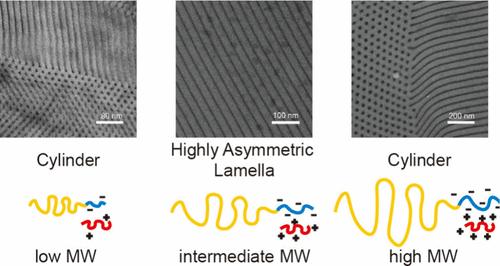聚电解质络合促成的聚苯乙烯-b-聚(丙烯酸)嵌段共聚物和聚(4-乙烯基吡啶)均聚物混合物中的高度不对称层状结构
IF 5.2
1区 化学
Q1 POLYMER SCIENCE
引用次数: 0
摘要
高度不对称片层(A-LAM)结构中,一层的厚度是另一层的数倍,这种结构在嵌段共聚物(BCP)纳米光刻中具有潜在的应用价值。在这项工作中,通过将聚苯乙烯-聚丙烯酸(PS-b-PAA)BCP 与聚(4-乙烯基吡啶)(P4VP)均聚物混合构建了 A-LAM 结构,其中 PAA 嵌段和 P4VP 均聚物可形成聚电解质复合物(PEC)。当官能团的混合比(nAA:n4VP)仅为 1:0.1,聚苯乙烯(PS)的体积分数(fPS)为 0.832 时,A-LAM 结构的厚度比(lPS:lPAA/P4VP)高达 4.95:1。P4VP 均聚物的分子量对 A-LAM 结构的形成影响不大。但是,当 PS-b-PAA BCP 的分子量过低或过高时,就无法在如此高的 fPS 下形成 A-LAM 结构。我们认为 PS 链的拉伸与 PAA/P4VP 相内的静电交联之间的竞争是形成 A-LAM 结构的决定因素。本文章由计算机程序翻译,如有差异,请以英文原文为准。

Highly Asymmetric Lamellar Structure in Blends of Polystyrene-b-Poly(acrylic acid) Block Copolymers and Poly(4-vinylpyridine) Homopolymers Facilitated by Polyelectrolyte Complexation
Highly asymmetric lamellar (A-LAM) structures, in which the thickness of one layer is several times larger than that of the other, have potential applications in block copolymer (BCP) nanolithography. In this work, A-LAM structures were constructed via blending polystyrene-b-poly(acrylic acid) (PS-b-PAA) BCPs with poly(4-vinylpyridine) (P4VP) homopolymers, in which the PAA block and P4VP homopolymers could form polyelectrolyte complexes (PECs). The A-LAM structure with the thickness ratio (lPS:lPAA/P4VP) of as high as 4.95:1 was achieved when the blending ratio of functional groups (nAA:n4VP) was only 1:0.1 and the volume fraction of polystyrene (PS) (fPS) was 0.832. The molecular weight of P4VP homopolymers has little effect on the formation of the A-LAM structure. However, when the molecular weight of PS-b-PAA BCPs is too low or too high, A-LAM structures cannot be formed at such a high fPS. We proposed that the competition between chain stretching of PS chains and the electrostatic cross-linking within PAA/P4VP phase is the determining factor for the formation of A-LAM structures.
求助全文
通过发布文献求助,成功后即可免费获取论文全文。
去求助
来源期刊

Macromolecules
工程技术-高分子科学
CiteScore
9.30
自引率
16.40%
发文量
942
审稿时长
2 months
期刊介绍:
Macromolecules publishes original, fundamental, and impactful research on all aspects of polymer science. Topics of interest include synthesis (e.g., controlled polymerizations, polymerization catalysis, post polymerization modification, new monomer structures and polymer architectures, and polymerization mechanisms/kinetics analysis); phase behavior, thermodynamics, dynamic, and ordering/disordering phenomena (e.g., self-assembly, gelation, crystallization, solution/melt/solid-state characteristics); structure and properties (e.g., mechanical and rheological properties, surface/interfacial characteristics, electronic and transport properties); new state of the art characterization (e.g., spectroscopy, scattering, microscopy, rheology), simulation (e.g., Monte Carlo, molecular dynamics, multi-scale/coarse-grained modeling), and theoretical methods. Renewable/sustainable polymers, polymer networks, responsive polymers, electro-, magneto- and opto-active macromolecules, inorganic polymers, charge-transporting polymers (ion-containing, semiconducting, and conducting), nanostructured polymers, and polymer composites are also of interest. Typical papers published in Macromolecules showcase important and innovative concepts, experimental methods/observations, and theoretical/computational approaches that demonstrate a fundamental advance in the understanding of polymers.
 求助内容:
求助内容: 应助结果提醒方式:
应助结果提醒方式:


